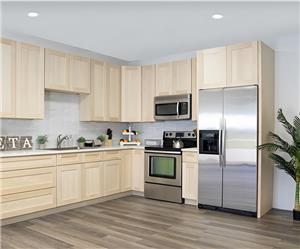Plywood vs MDF vs Particle Board: Difference and Comparison(2)
What is MDF Wood?
The name MDF refers to medium-density fiberboard, a composite wood engineered using wood fibers. The wood fibers used for MDF are very fine, so the resulting fiberboard doesn’t have noticeable wood grain, knots, or rings. Fibers, heat, and glue are used to make tight fiberboards.
Either softwood or hardwood can be used to make MDF. Either way, the resulting fiberboard is denser and stronger than plywood. It also has veneer sealant applied to it to make the composite wood resistant to water damage. It makes MDF an excellent substrate for melamine, thermofoil, veneer, heavy lacquer, and vinyl.
Types of MDF wood
There are two basic types of MDF wood, which are:
Moisture resistant – often used in wet areas like bathrooms
Fiber retardant – used in places where fires or heat often occur such as the kitchen
Quality & Cost
MDF wood is much sturdier than plywood, so its quality is good. It is also much better than traditional wood as it virtually has no imperfections. It always comes primed, ready for painting, and has no twists or warps. In terms of cost, it is more expensive compared to particleboard but is cheaper to replace than plywood.
Advantage of MDF
MDF wood has three main advantages – it’s low-priced, is not susceptible to voids and wood knots, and can hold paint easily thanks to its smooth surface. It can also handle high loads, but not too much weight. MDF is an all-purpose material capable of handling a range of jobs despite the low price.
Perhaps one of its best advantages is its manufacturing process that is similar to recycling, so creating MDF wood saves trees. Thanks to the chemicals used in its processing, MDF resists some insects. With its excellent density, it is easy enough to handle MDF for various wood projects.
Disadvantage of MDF
One of the most significant disadvantages of MDLF wood is it’s weaker than natural wood, so it isn’t ideal to use for shelves. It does not last long, which means a loss of money even though it is considerably cheaper. It is also easily damaged, buckling fairly easily under pressure.
MDF is also more water-absorbent, which makes it swell over time. As such, you must be conscious when using it. It also doesn’t work well with screws or nails. If punctured with a nail, a fraction may appear. The worst disadvantage is it contains formaldehyde, so you don’t want to inhale its dust.




